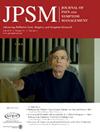在患有神经系统疾病的婴儿家庭会议中讨论精神问题。
IF 3.2
2区 医学
Q2 CLINICAL NEUROLOGY
引用次数: 0
摘要
简介:灵性是理解和应对重病的一种机制,但人们对家庭和临床医生如何在儿科家庭会议中融入灵性却知之甚少:灵性是理解和应对严重疾病的一种机制,但人们对家庭和临床医生如何在儿科家庭会议中融入灵性却知之甚少:目的:我们试图描述在护理患有神经系统疾病的婴儿的家庭和临床医生之间的会议中精神陈述的频率和性质:在这项描述性定性研究中,我们使用了一个现有的数据集,该数据集是对患有神经系统疾病的婴儿的家庭会议进行录音、去标识和转录的。婴儿的纳入标准为:1)年龄小于 1 岁;2)患有神经系统疾病;3)计划进行有关神经系统疾病预后或护理目标的谈话。我们采用内容分析法对数据进行编码:我们为 24 名婴儿和 36 名家长召开了 68 次家庭会议。大多数家长(n=32/36,89%)自我认同为有灵性。32%的会议(n=22/68)提到了灵性。灵性讨论包括 3 个方面:1)灵性信仰和实践;2)灵性支持;3)神圣的亲子关系。临床医生对家庭成员灵性陈述的回应并不一致,包括提供肯定、探讨护理目标以及继续讨论临床信息:结论:约三分之一的家庭会议讨论了灵性问题。临床医生参与灵性讨论的程度不一。这些发现突出表明,有必要就何时以及如何在与重症婴儿家属的对话中讨论灵性问题进行培训。本文章由计算机程序翻译,如有差异,请以英文原文为准。
Discussion of Spirituality in Family Conferences of Infants With Neurologic Conditions
Introduction
Spirituality serves as a mechanism to understand and cope with serious illness, yet little is known about how families and clinicians incorporate spirituality in pediatric family conferences.
Objectives
We sought to characterize the frequency and nature of spiritual statements in conferences between families and clinicians caring for infants with neurologic conditions.
Methods
In this descriptive qualitative study, we used an existing dataset of audio-recorded, de-identified, transcribed family conferences of infants with neurologic conditions. Inclusion criteria for infants were 1) age < 1 year, 2) presence of a neurologic condition, and 3) planned conversation about neurologic prognosis or goals of care. We used a content analysis approach to code the data.
Results
68 family conferences were held for 24 infants and 36 parents. Most parents (n = 32/36, 89%) self-identified as spiritual. References to spirituality occurred in the 32% of conferences (n = 22/68). Spiritual discussion included three domains: 1) Spiritual beliefs and practices, 2) Spiritual support, and 3) Parent-child connection as sacred. Clinicians’ responses to family member spiritual statements were inconsistent and included providing affirmation, exploring goals of care, and continuing discussion of clinical information.
Conclusions
Spirituality was discussed in approximately one-third of family conferences. Clinician engagement with spirituality discussion was variable. These findings highlight a need for training on when and how to discuss spirituality in conversations with families of seriously ill infants.
求助全文
通过发布文献求助,成功后即可免费获取论文全文。
去求助
来源期刊
CiteScore
8.90
自引率
6.40%
发文量
821
审稿时长
26 days
期刊介绍:
The Journal of Pain and Symptom Management is an internationally respected, peer-reviewed journal and serves an interdisciplinary audience of professionals by providing a forum for the publication of the latest clinical research and best practices related to the relief of illness burden among patients afflicted with serious or life-threatening illness.

 求助内容:
求助内容: 应助结果提醒方式:
应助结果提醒方式:


